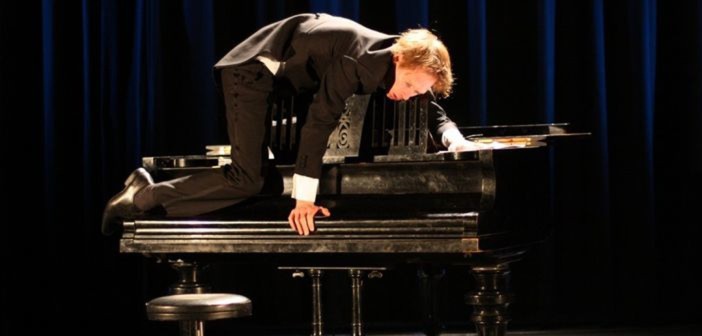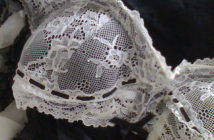There is, from the TPC’s viewpoint anyway, something inherently comic about pianos, especially grand ones. (Although the upright still occupying space on the stage at the Te Puna Memorial Hall no doubt has some funny stories to tell.)
The TPC has been collecting weird Internet accounts of pianos and their fates: (for a sample, try http://www.bbc.com/news/magazine-19706812 ) for some years now. Starting from when the Steinway intended for the Wellington Town Hall soared off the deck of its container ship and was lost forever in a storm in the Bay of Biscay. Ker-plunk is a cliché: all the same, I would have loved to have been there to hear it.
So it was no difficulty at all to play along with the ghastly difficulties, mostly self-induced, of The Pianist who took a very long run-up to actually producing some music from a Very Special Piano at Baycourt XSpace on Monday 13 May. Everything was against him. Nothing was wasted, except maybe the pot of red geraniums that decorated his dressing room. All the rest of the set got used, from the ‘specially stretchy drapes to the chandelier and even the bowl of popcorn as (spoiler alert!) the piano emitted clouds of smoke. Even the sound/lighting person had to defend his/her position.
The music itself came in for a particularly bad time. The manuscript was underarmed (several times), folded, bundled, scrungled, torn, given out, thrown about, unscrambled, used up, and only eventually, and I think really, played. (The Pianist’s motor control was such that it was possible he co-ordinated his mime exactly with the sound/lighting person’s skills. But I think he had a cleverer piano even than that.)
How lovely it was to see some fun made of The Piano. It started life in the show as a stage. Slippery, but reliable. And high. Irreverently, it lost its leg, causing an amazing fox-and-goose problem as The Pianist sorted out the relative benefits of having an instrument that would stay on the level while also allowing him somewhere to sit and play. There were lots of jokes about the what-we-sit-upon, which certainly suited a full-house audience that – refreshingly different from your usual Baycourt attendees – ranged from young front-row commentators delighted to point out the dangers confronting him (and others prepared to pat him on his sit-upon) to equally young back-row protagonists actively prepared to take him on.
There was also a virtual piano, vividly mimed when it became clear that that was the only way The Pianist would get his place in the spotlight. At this point his relationship with the support crew was at an all-time low.
Fortunately for our peace of mind, the leg to the real instrument eventually got reconnected and the chandelier stopped bashing him and it seemed even possible that the music stand would co-operate… and we were treated to an amazing ballet of the fingers as The Pianist organised the right height for the stool he had wrested from the personnel at the sound desk. We were happy, because life for The Pianist was clearly an unending struggle.
Did he even like, or dislike, his audience? We weren’t always clear. He could not have orchestrated the ker-plunked wine glass or the cell-phone that went off in the row just in front of the TPC, but he did let us know what he felt about such things. We were sometimes complicit, sometimes actively antagonistic, in his world. We did like him enough to want him to succeed. We loved his jokes, as he fought his way towards achieving a space in which he could play his music. But we were also anxious for him, aware that he needed to get his music played… which is why, when his access to the keyboard was confined to three notes, accessible only via a screwdriver, we accepted his very much reduced score.
I loved this show. It was a wonderfully-calibrated display by Tom Monckton of physical theatre posed against aesthetic conventions. It showed up how life has to be lived – coping with performance anxiety and using whatever props you can devise – as truthfully expressed as you will ever see it. Even the loving, then duelling, knee puppetry showed us how bluff can turn to catastrophe in the blink of, well, a knee.





